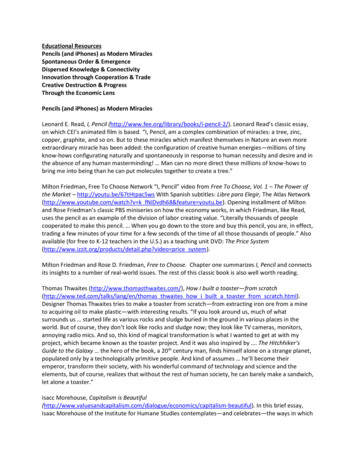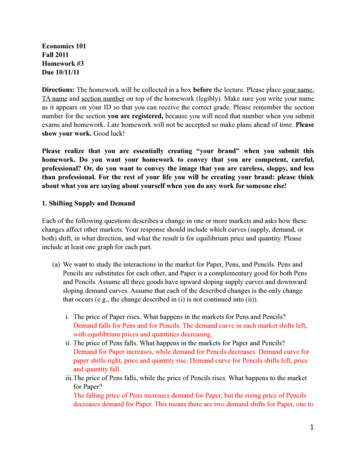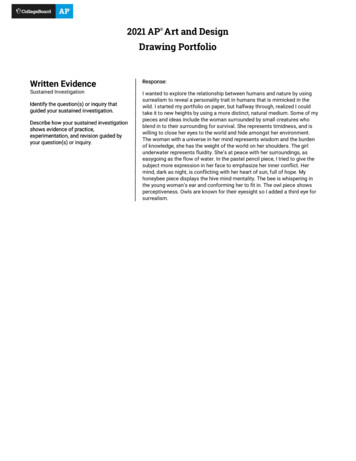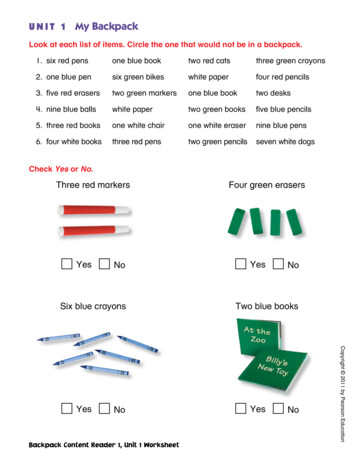
Transcription
Educational ResourcesPencils (and iPhones) as Modern MiraclesSpontaneous Order & EmergenceDispersed Knowledge & ConnectivityInnovation through Cooperation & TradeCreative Destruction & ProgressThrough the Economic LensPencils (and iPhones) as Modern MiraclesLeonard E. Read, I, Pencil (http://www.fee.org/library/books/i-pencil-2/). Leonard Read’s classic essay,on which CEI’s animated film is based. “I, Pencil, am a complex combination of miracles: a tree, zinc,copper, graphite, and so on. But to these miracles which manifest themselves in Nature an even moreextraordinary miracle has been added: the configuration of creative human energies—millions of tinyknow-hows configurating naturally and spontaneously in response to human necessity and desire and inthe absence of any human masterminding! Man can no more direct these millions of know-hows tobring me into being than he can put molecules together to create a tree.”Milton Friedman, Free To Choose Network “I, Pencil” video from Free To Choose, Vol. 1 – The Power ofthe Market – http://youtu.be/67tHtpac5ws With Spanish subtitles: Libre para Elegir, The Atlas Network(http://www.youtube.com/watch?v k fNiDvdh68&feature youtu.be). Opening installment of Miltonand Rose Friedman’s classic PBS miniseries on how the economy works, in which Friedman, like Read,uses the pencil as an example of the division of labor creating value. “Literally thousands of peoplecooperated to make this pencil. When you go down to the store and buy this pencil, you are, in effect,trading a few minutes of your time for a few seconds of the time of all those thousands of people.” Alsoavailable (for free to K-12 teachers in the U.S.) as a teaching unit DVD: The Price deo price system).Milton Friedman and Rose D. Friedman, Free to Choose. Chapter one summarizes I, Pencil and connectsits insights to a number of real-world issues. The rest of this classic book is also well worth reading.Thomas Thwaites (http://www.thomasthwaites.com/), How I built a toaster—from scratch(http://www.ted.com/talks/lang/en/thomas thwaites how i built a toaster from scratch.html).Designer Thomas Thwaites tries to make a toaster from scratch—from extracting iron ore from a mineto acquiring oil to make plastic—with interesting results. “If you look around us, much of whatsurrounds us started life as various rocks and sludge buried in the ground in various places in theworld. But of course, they don’t look like rocks and sludge now; they look like TV cameras, monitors,annoying radio mics. And so, this kind of magical transformation is what I wanted to get at with myproject, which became known as the toaster project. And it was also inspired by . The Hitchhiker’sGuide to the Galaxy the hero of the book, a 20th century man, finds himself alone on a strange planet,populated only by a technologically primitive people. And kind of assumes he’ll become theiremperor, transform their society, with his wonderful command of technology and science and theelements, but of course, realizes that without the rest of human society, he can barely make a sandwich,let alone a toaster.”Isacc Morehouse, Capitalism is gue/economics/capitalism-beautiful). In this brief essay,Isaac Morehouse of the Institute for Humane Studies contemplates—and celebrates—the ways in which
capitalism helps people build a moral social order by encouraging and facilitating voluntary cooperation,as well as mutually beneficial exchange. “A group of volunteers cleaning up and rebuilding homes after adisaster is beautiful. But consider that the same disaster, if markets are allowed to operate, will causemillions of people living thousands of miles away to reduce their consumption of needed water,plywood, generators and flashlights so that those in the affected areas can get enough. It will inducecomplete strangers, some of whom don’t even know of the disaster, to channel their energies towardthe production and distribution of goods to the victims of the storm.”iPhone 5 Travels 20,096 Miles Before Ending Up in Your ney/). An informative and entertaining graphicillustration of the miracle of coordination and value creation that is iPhone 5’s global supply chain.Virginia Postrel, Why We Prize That Magical Mystery 704758904576188511633084364.html). Syndicatedcolumnist Virginia Postrel considers how innovators in a market economy can create extraordinarygoods and services that we come to take for granted as they become widely adopted. “Extraordinarilyrare even among the most accomplished seamstresses, chefs and carpenters are those who spin theirown fibers, thresh their own wheat or trim their own lumber—all once common skills. Rarer still is theLinux hacker who makes his own chips. Who among us can reproduce from scratch every component ofa pencil or a pencil skirt? We don’t notice their magic—or the wonder of electricity or eyeglasses,anesthesia or aspirin—only because we’re used to them.”Michelle Malkin, The miracle of a lead alkin071000.asp). Bestselling author and syndicatedcolumnist Michelle Malkin discusses the lessons of I, Pencil and its continuing value to educators today.“‘I, Pencil’ teaches It is individuals, cooperating peacefully and voluntarily, working together withoutmandate or central design, who produce the world’s goods and services.”Economics of Pencil Making aking/). The Story ofPencils ). A nuts-and-bolts explanation of thecomplex process involved in making the humble pencil.Free To Choose Network, Free or Equal (http://youtu.be/Z5QM2CUmqGc). Swedish author, historianand globalization advocate, Johan Norberg discusses the lessons of I, Pencil and how markets andcompetition encourage peace and prosperity.Lewis Foster, I, Pencil Family Tree and Documentary nd-documentary-by-lewis-foster/). A project of the Foundation for Economic Education that maps outeverything that goes into the making of a pencil; also features an enhanced video of Milton Friedman’suse of a pencil as an example of the division of labor.The Institute for Faith, Work, and Economics, I, Smartphone (http://tifwe.org/smartphone/). Areworking of I, Pencil that uses a more technologically advanced product as an example of the wealthcreated by the division of labor and market exchange.Spontaneous Order & Emergence
F.A. Hayek, The Use of Knowledge in Society l). Inthis classic 1945 essay published in the American Economic Review, Economics Nobel Prize Winner F.A.Hayek explains the decentralized nature of knowledge in society. “The peculiar character of the problemof a rational economic order is determined precisely by the fact that the knowledge of thecircumstances of which we must make use never exists in concentrated or integrated form but solely asthe dispersed bits of incomplete and frequently contradictory knowledge which all the separateindividuals possess.”Russ Roberts, A Marvel of Cooperation: How Order Emerges without a Conscious 05/Robertsmarvel.html). Roberts makes much the samepoint as Hayek while inspiring a sense of wonder at what people can accomplish when they worktogether peacefully.Norman Barry, The Tradition of Spontaneous ty/bryTSO.html). This lengthy essay (about 50 pages)traces the long history of spontaneous order from the Middle Ages through the 20th century. Along theway, the reader meets many of history’s important thinkers.The Institute for Humane Studies, Spontaneous Order and the Market neous-order-and-market-process). St. Lawrence Universityeconomics professor Steven Horwitz discusses in depth the economic concepts articulated in I, Pencil.Russ Roberts, The Price of Everything: A Parable of Possibility and html) "Improbable as it might seem, perhaps the mostimportant fact for a voter or politician to know is: No one can make a pencil. That truth is the essence ofa novella that is, remarkably, both didactic and romantic. Even more remarkable, its author is aneconomist. If you read Russell Roberts's The Price of Everything: A Parable of Possibility andProsperity you will see the world afresh. . . ."--George Will, NewsweekF.A. Hayek, Individualism and Economic Order. A collection of Hayek’s most famous articles, including“The Use of Knowledge in Society”, “Economics and Knowledge”, and more.Thomas Sowell, A Conflict of Visions: Ideological Origins of Political Struggles. Sowell compares theconstrained and unconstrained visions of the world. The unconstrained vision believes in the power ofintellectuals to plan and achieve desired social results. The constrained vision, similar to Hayek, believesthe world is too complicated for such plans to work, and prefers ever-evolving, bottom-up spontaneousorder processes.William Easterly, The Rich Man’s Burden: Why the West’s Efforts to Aid the Rest Have Done So Much Illand So Little Good. The title, drawn from Kipling, refers to the West's haughty condescension towardsthe Rest. Easterly draws a dichotomy between Planners -- top-down, grandiose, and bureaucratic -- andSearchers, who take a more bottom-up, humble, and effective approach to aid.Virginia Postrel, The Future and Its Enemies. The future belongs to dynamists – people who are open toeconomic, cultural, and technological change, even though nobody knows quite where we’ll end up. Itsenemies are stasists, who prefer the comfort and security of the world they know and wish to stop thechanges wrought by spontaneous order processes.
Michael Shermer, The Believing Brain. This book is about how the brain forms beliefs. Our brains havehardwired traits that Shermer calls “patternicity” and “agenticity,” which means that our brains findpatterns in everything, and also assume that someone is behind those patterns. This is an evolutionaryexplanation of why most people are skeptical, if not hostile, to the idea of spontaneous order.Dispersed Knowledge & ConnectivityMatt Ridley, Collective Intelligence on the Edge telligence-on-the-edge.aspx) and Humans: Why They 052748703691804575254533386933138.html?mod WSJ hpeditorsPicks). Syndicated columnist Matt Ridley explores the notion of “collective intelligence”—theknowledge dispersed throughout society which only trade can bring together, allowing people to put itinto action. “Human achievement is based on collective intelligence—the nodes in the human neuralnetwork are people themselves. By each doing one thing and getting good at it, then sharing andcombining the results through exchange, people become capable of doing things they do not evenunderstand. As the economist Leonard Read observed in his essay “I, Pencil” (which I’d like everybody toread), no single person knows how to make even a pencil—the knowledge is distributed in societyamong many thousands of graphite miners, lumberjacks, designers and factory workers.”Matt Ridley, When Ideas Have Sex(http://www.ted.com/talks/matt ridley when ideas have sex.html). At a July 2010 lecture at OxfordUniversity, Ridley explores the self-reinforcing cycle of innovation that results when people and ideasinteract with each other. “Ask yourself how long you would have to work to provide for yourself an hourof reading light this evening to read a book by. If you had to start from scratch—let’s say you go out intothe countryside, you find a sheep, you kill it, you get the fat out of it, you render it down, you make acandle, etc., etc.—how long is it going to take you? Quite a long time. How long do you actually have towork to earn an hour of reading light if you’re on the average wage in Britain today? And the answer isabout half a second.”Matt Ridley, The Rational Optimist: Everybody is working for everybody else(http://www.youtube.com/watch?feature player embedded&v lOQGiveUxf8 ). And at Zurich Minds(http://www.youtube.com/watch?feature player embedded&v GdUwctqBmFY). Ridley highlights howmarket interactions depend on people doing things for each other, enabling the average person today toenjoy luxuries that were once the province of nobility. “Louis XIV had 498 people to prepare his dinnerevery night. But you know what? Every single one of you has 498 people to prepare your dinner tonight.They’re working in cafés and bistros and restaurants and shops all over town, but each of them is readyat an hour’s notice to give you an extremely good meal that is probably less likely to have salmonella init than Louis XIV’s did.”Matt Ridley, The Rational Optimist: How Prosperity Evolves. In a way, this is Adam Smith’s Wealth ofNations as written by an evolutionary biologist. Connectivity is the key to prosperity. People trade muchmore than goods when they interact. They also trade ideas. The more people interact, the faster newideas can meet each other and evolve, and the faster technology advances.Adam Smith, The Theory of Moral Sentiments. Man is an inherently social animal. This insight ofconnectivity is at the core of Smith’s impartial spectator theory of morality.
Adam Smith, An Inquiry into the Nature and Causes of the Wealth of Nations. The division of labor,trade, and other economic essentials only work in social settings. And social settings only work whenpeople are left relatively free. This lengthy book is not for beginners, but it’s also much moreapproachable than its reputation suggests.Innovation through Cooperation & TradeFrederic Bastiat, “There Are No Absolute %20Absolute%20Principles). In this short chapter from Economic Sophisms, Bastiat reflects on how astonishing itis that a city as big as Paris, which has no farms and nobody in charge of food distribution, is somehowfed every day.Free Trade (http://www.izzit.org/products/detail.php?video free trade) teaching unit DVD is availablefor free to K-12 teachers in the U.S.The Institute for Humane Studies, “Trade is Made of Win,” Part 1: Wealth e-made-win-part-1-wealth-creation) and “Trade is Made ofWin,” Part 2: Cooperation n-part-2-cooperation)and “Trade is Made of Win,” Part 3: Conservation -part-3-conservation). In this three-part series, Samford College economics professor Art Cardendebunks the myths that trade creates winners and losers, social conflict, and waste. Rather, he explainshow voluntary trade benefits all parties involved, increases social cooperation, and allows for moreefficient use of resources. “Trade is a positive sum game, meaning that when people can trade, they canproduce more stuff than they would be able to if they didn’t trade.” “Also, trade conserves wealth. If wewant to produce a given quantity of output, we can produce it using fewer inputs, using fewer resourcesif we have an opportunity to trade.”The Institute for Humane Studies, Does Trade Promote Peace ote-peace). Duquesne University economics professor Pavel Yakovlev discusses an oftenoverlooked benefit of free trade: its ability to promote world peace. “If you look at countries that tradea lot with each other, these are some of the countries that import many ideas from the rest of theworld. So free trade comes with not just goods but it also comes with exchange of ideas and culture,making countries more tolerant of each other’s differences and more understanding.”Martin Wolf, Why Globalization Works.A classic discussion of the genre that reads well.Donald J. Boudreaux, Globalization. Boudreaux combines clarity and passion with a deep knowledge ofthe subject.Jagdish Baghwati, In Defense of Globalization. Baghwati’s classic mix of erudition and wit finds that if asociety is to be free and prosperous, it must also be open to the world.Dan Griswold, Mad about Trade. A heartfelt and clearly written defense of free trade.William Easterly, The Elusive Quest for Growth. Why are some countries rich while others are poor? Howcan poor countries become rich? Easterly finds that diagnosing the problem is easy, but implementing
the solutions is much more difficult. Easterly is a well-known critic of top-down foreign aid. He argues abottom-up approach is much more effective.Creative Destruction & ProgressMarian Tupy, The Miracle that Is the iPhone (or How Capitalism Can Be Good for the good-for-theenvironment/) and Dematerialization (Update) pdate/). Using the iPhone as an example, the Cato Institute’s Marian Tupy explains how marketinnovation leads to “dematerialization”—doing more with less—which means more efficient use ofresources and a healthier environment. “Dematerialization should be welcome news for those whoworry about the ostensible conflict between the growing world population on the one hand andavailability of natural resources on the other hand. dematerialization will better enable our species togo on enjoying material comforts and be good stewards of our planet at the same time.”The Institute for Humane Studies, An Introduction to the Industrial roduction-industrial-revolution). Steve Davies of the Institutefor Economic Affairs points out how the industrial revolution unleashed unprecedented economicgrowth and innovation. “In the course of the 19th century, average incomes per capital in the UnitedKingdom rose by a factor of six. In other words, people in 1900 were six times better off than they hadbeen—or their ancestors had been, rather—100 years earlier.”The Institute for Humane Studies, Are Entrepreneurs Modern Day trepreneurs-modern-day-heroes). University of San Diegolaw professor explains how entrepreneurs thrive by meeting other people’s needs. “Entrepreneurs havethe opportunity to match their passions and their strengths with some unmet need in society. And theclassic entrepreneur is somebody who is able to identify where there’s a need that hasn’t been met andrush in there and try to provide it.”Deirdre McCloskey, Bourgeois Dignity: Why Economics Can’t Explain the Modern World. What causedmodern prosperity? McCloskey thinks it was a change in rhetoric and public opinion around the time ofthe Enlightenment. Institutions, markets, and all the usual economic explanations certainly matter. Butfirst, people had to lose their hostility towards commerce and a bourgeois lifestyle. McCloskey is asuperb writer; this book is a joy for anyone to read.Thomas K. McCraw, Prophet of Innovation: Joseph Schumpeter and Creative Destruction. This superbSchumpeter biography is a much easier read than Schumpeter’s books. McCraw masterfully blendsSchumpeter’s very eventful life story with clear explanations of his ideas and works.Joseph Schumpeter, Capitalism, Socialism, and Democracy. Schumpeter’s most famous work containshis creative destruction theory that was so central to his thought.Through the Economic LensFaustino Ballvé, Essentials of Economics. Educated in Spain and England, Faustino Ballvé taught andpracticed law in Mexico City, when Ludwig von Mises spoke there on a lecture tour. Mises’s talkssparked a new intellectual energy in Ballvé, who then carried on a long correspondence with Mises. The
result of his studies and correspondence is this splendid book. First published first in 1956, it had amassive impact in Latin America, and was translated and published in English in 1965. At only 129 pages,it is a concise and accessible, yet comprehensive introduction to economic theory for all audiences.David D. Friedman, Hidden Order: The Economics of Everyday Life. One of the best introductions toeconomics ever written. Full of compelling and often counterintuitive examples, such as how the U.S.grows many of its cars in Iowa (p. 70).Steven Landsburg, The Armchair Economist. Another introduction to economics, on par with Friedman’s.A new edition, published in 2012, updates and expands on the original.Thomas Sowell, Basic Economics. Slightly more technical than Landsburg or Friedman, but Sowell’slegendary clarity makes this book excellent for its intended audience of beginners.Thomas Sowell, Applied Economics. A sequel of sorts to Basic Economics that applies the theories andprinciples from that book to several real-world policy issues.
way, the reader meets many of historys important thinkers. The Institute for Humane Studies, Spontaneous Order and the Market Process . Thomas Sowell, A Conflict of Visions: Ideological Origins of Political Struggles. Sowell compares the constrained and unconstrained visions of the world. The unconstrained vision believes in the power of










